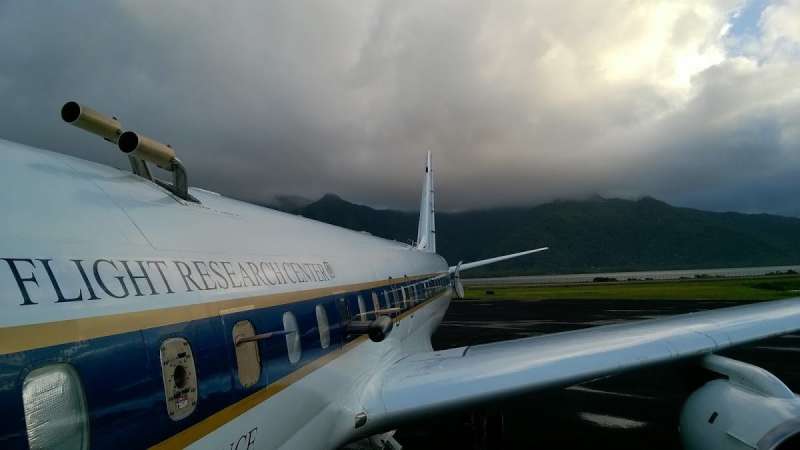A view of the troposphere from an airplane. Credit: Nick Juhasz
Ambient aerosols – those tiny mixtures of liquids and solids suspended in air – play important roles in Earth's climate, so much so that scientists are heading to remote locations to better understand them.
Earth's atmosphere is a complicated system. It's impossible to measure every aspect of it everywhere all the time. Models can describe the atmosphere over a large scale, but they rely on an understanding of the processes occurring in the atmosphere. Laboratory experiments and field observations can supply information on those processes. Ambient aerosols are one complex ingredient of the atmosphere that is particularly challenging for models. They have significant effects including their ability to directly absorb or reflect the light entering the Earth's atmosphere. To match observations, modelers need to know how and when the chemical components of the aerosols enter and exit the system.
One missing piece of the puzzle is what happens to the organics, which account for about half the mass of aerosols, in the remote free troposphere. The free troposphere is the normally nonturbulent region of the atmosphere above the region that is directly influenced by Earth's surface. Scientists reported at the 2017 American Geophysical Union Fall Meeting in New Orleans that the lifetime of organic aerosols in this region is on the order of 10 days, far shorter than scientists previously assumed. In the new research, scientists used new methods to make these estimates based on data collected during flights in the first two Atmospheric Tomography Mission (ATom) campaigns.
Figuring out how long aerosols hang around is absolutely necessary to balance the variables in models, according to Charles Brock, a physicist with NOAA who worked on a separate ATom project. "The implications of that are very large for climate change, because these particles affect clouds and the radiation budget of the Earth," Brock said.
On average, organic aerosols live in the atmosphere for 6 days, but that value applies more for the well-studied regions above or close to the continents, according to Pedro Campuzano Jost, an atmospheric chemist at the Cooperative Institute for Research in Environmental Sciences in Boulder, Colorado, who presented the new research. For the remote oceanic regions studied in ATom, modelers assumed aerosols were leaving the atmosphere by being washed out by precipitation or falling to the ground and that it was an even slower process in the nonturbulent free troposphere. So their current models overestimate a lifetime of about 40 days.
Sampling lines outside the NASA DC-8 used for ATom. Credit: Benjamin Nault / CIRES
ATom uses a NASA DC-8 aircraft equipped instruments that sample the atmosphere over the Pacific and Atlantic Oceans to learn how human-produced air pollution transforms the chemistry of the atmosphere, particularly in remote areas where measurements are lacking. In the new research, Jost and his coauthors used the aircraft's instruments to determine the chemical composition of aerosols over the two oceans. ATom provided them snapshots of the atmospheric chemistry over summer 2016 and winter 2017. Each campaign consisted of 11 flights over a 23-day period. The aircraft flew up and down from about 180 meters (590 feet) off the ocean surface up to 12 kilometers (7.5 miles) in altitude to capture the chemical and physical characteristics of the gases and aerosols in the air samples over a continuous range of altitudes.
The researchers used these measurements to determine the age of the air masses sampled by the plane – or how long the aerosols had been in the atmosphere. They determined the age of the organic aerosols with a photochemical clock. Because nonmethane hydrocarbons are ubiquitous in the troposphere, they can serve as indicators of the aging photochemical processes. Previous studies have found the concentration ratio of two different hydrocarbons is most useful, because it's not as sensitive to dilution as the concentrations alone are. The clock based on the ethane/propane ratio was the most suitable for the timeframe considered in this study, explained Jost.
With this clock, the researchers estimated a lifetime for organic aerosols in the remote free troposphere of 8-12 days. Jost doesn't yet know the exact mechanism for this shorter lifetime, but future model simulations may give him a clue. The possibilities, he said, include direct degradation of the organic aerosols by sunlight or degradation of the organic material by trace radicals that are produced by sunlight.
"We know there's a large uncertainty in the radiative impact of aerosols, both direct and indirect effects," said Megan Willis, a chemist at the University of Toronto who was not involved with the new research. "One of the most important quantities that we need to get a handle on to start to close those error bars and to reproduce aerosol models is how efficiently is it removed or what is the timescale on which it is removed." Willis said she was excited to see the measurements presented in the poster as they can improve the current models.
Jost next plans to incorporate ATom data collected in fall 2017 and data to be collected in spring 2018. Adding in the upcoming data will make the findings more robust, he said.
Provided by American Geophysical Union
This story is republished courtesy of AGU Blogs (http://blogs.agu.org), a community of Earth and space science blogs, hosted by the American Geophysical Union. Read the original story here.
























